FOTO: Rămășitele unui fost sclav, devenit un magistrat roman bogat după eliberare, au fost descoperite la Pompeii
O echipă de arheologi spanioli a identificat rămăşiţele mumificate ale unui bogat magistrat roman. Mormântul s-a păstrat intact sub straturile de cenuşă vulcanică din Parcul Arheologic Pompeii. Descoperirea este una cu totul inedită, spun specialiștii, pentru că osemintele aparțin unui fost sclav, Marcus Venerius Secundio, care după ce a fost eliberat a făcut avere şi a dobândit un statut social privilegiat.
"A fost o surpriză pentru toată lumea, chiar şi pentru specialistul nostru în arheologia mormintelor", a declarat directorul parcului arheologic, germanul Gabriel Zuchtriegel, transmite Digi24.
Descoperirea este considerată specială din mai multe motive. Conform experţilor, rămăşiţele omeneşti au putut fi identificate ca aparţinând fostului sclav Marcus Venerius Secundio, care, după ce a fost eliberat, a făcut avere şi a dobândit un statut social privilegiat ca magistrat roman.
Marcus Venerius Secundio este un exemplu de succes în societatea romană a secolului I. Sclav în templul lui Venus din Pompeii, Marcus Venerius Secundio a reuşit să-şi obţină eliberarea şi apoi a devenit magistrat şi gardian al cultului imperial. Această poziţie privilegiată i-a permis să-şi dezvolte pasiunea pentru "libertăţile cu care Roma şi-a sedus oponenţii", după cum scria istoricul roman Titus Livius - şi astfel Secundio a început să finanţeze punerea în scenă a unor piese de teatru.
Inscripţiile din mormântul său, din necropola Porta Sarno din Pompeii, vorbesc de asemenea despre momentele importante din viaţa sa. Cercetători de la Universitatea din Valencia au început să excaveze mormântul său în luna iulie şi au reuşit să pătrundă în interiorul mormântului în urmă cu doar două săptămâni. Ei au descoperit cel mai bine conservat corp uman din Pompeii şi singurul cadavru cu semne evidente de mumificare.
Venerius a murit la vârsta de 60 de ani. Modul în care i s-a conservat părul, cartilagiul urechii şi osemintele reprezintă un veritabil miracol din punct de vedere biologic, care se adaugă opulenţei arhitecturale a mormântului său, ceea ce face ca această descoperire să fie considerată cu adevărat specială.
Decorat cu o frescă reprezentând o livadă, mormântul prezintă pe faţada sculptată în stuc mesajul "A oferit reprezentaţii în Greacă şi Latină timp de patru zile", mesaj care atestă, conform antropologului Llorenç Alapont, directorul ştiinţific al cercetării coordonate de Parcul Arheologic Pompeii, că în acest oraş roman erau organizate reprezentaţii ale unor piese de teatru greceşti. "Un alt indiciu că (Pompeii) era un oraş cosmopolit".
Conform arheologilor, acest mormânt aparţine ultimelor decenii din viaţa oraşului Pompeii care a fost îngropat de o erupţie a Vezuviului din anul 79 d.Hr. Redescoperit în secolul XVIII, oraşul istoric Pompeii a devenit unul dintre cele mai complexe şantiere şi parcuri arheologice din lume, precum şi o extraordinar de populară destinaţie turistică.
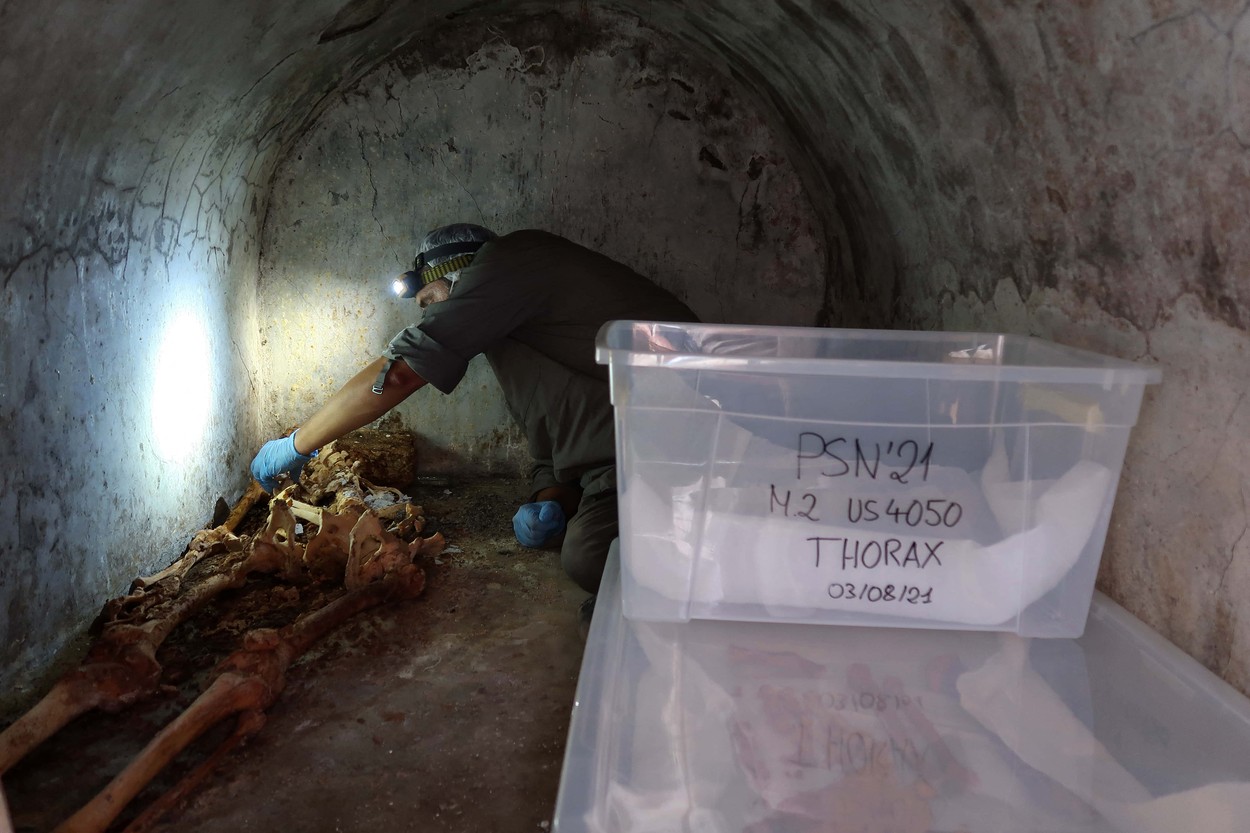 Mummified remains, along with the hair and bones of an individual buried in an ancient tomb have been found at the necropolis of Porta Sarno, to the east of the ancient urban centre of Pompeii, Italy on August, 2021. It is one of the best preserved skeletons ever found in the ancient city. The deceased, Marcus Venerius Secundio a public slave and custodian of the Temple of Venus, was buried in a small cell of 1.6 x 2.4 metres, located behind the main façade, while in the remaining part of the enclosure evidence of cremation has been found, in the form of two cinerary urns, one of which is a beautiful glass container belonging to a woman by the name of Novia Amabilis. During the Roman period at Pompeii, funeral rites usually involved cremation, while only small children were buried.
The burial of Marcus Venerius is thus highly unusual also for the funeral rite that was adopted, considering that he was an adult man over 60 years of age, as evidence emerging from the initial analysis of bones found in the burial chamber indicates. The characteristics of the funerary chamber, which consisted of a hermetically sealed room, created conditions that allowed for the exceptional state of preservation in which the skeleton was found, with hair and an ear still visible. Furthermore, grave goods have been recovered, including two glass unguentaria and numerous fragments of what appears to be fabric. On a marble slab located on the pediment of the tomb, a commemorative inscription to the owner Marcus Venerius Secundio makes reference, extraordinarily, to performances at Pompeii that were conducted in Greek. Experts said it was the first confirmation that Greek was used alongside Latin. The tomb structure, which dates to the final decades in the life of the city, consists of a masonry enclosure, with traces of paint preserved on the façade: it is possible to distinguish green plants on a blue background. The city of Pompeii was destroyed by a volcanic eruption in AD 79. PHOTO: ABACAPRESS.COM,Image: 627471143, License: Rights-managed, Restrictions: , Model Release: no, Credit line: Profimedia
Mummified remains, along with the hair and bones of an individual buried in an ancient tomb have been found at the necropolis of Porta Sarno, to the east of the ancient urban centre of Pompeii, Italy on August, 2021. It is one of the best preserved skeletons ever found in the ancient city. The deceased, Marcus Venerius Secundio a public slave and custodian of the Temple of Venus, was buried in a small cell of 1.6 x 2.4 metres, located behind the main façade, while in the remaining part of the enclosure evidence of cremation has been found, in the form of two cinerary urns, one of which is a beautiful glass container belonging to a woman by the name of Novia Amabilis. During the Roman period at Pompeii, funeral rites usually involved cremation, while only small children were buried.
The burial of Marcus Venerius is thus highly unusual also for the funeral rite that was adopted, considering that he was an adult man over 60 years of age, as evidence emerging from the initial analysis of bones found in the burial chamber indicates. The characteristics of the funerary chamber, which consisted of a hermetically sealed room, created conditions that allowed for the exceptional state of preservation in which the skeleton was found, with hair and an ear still visible. Furthermore, grave goods have been recovered, including two glass unguentaria and numerous fragments of what appears to be fabric. On a marble slab located on the pediment of the tomb, a commemorative inscription to the owner Marcus Venerius Secundio makes reference, extraordinarily, to performances at Pompeii that were conducted in Greek. Experts said it was the first confirmation that Greek was used alongside Latin. The tomb structure, which dates to the final decades in the life of the city, consists of a masonry enclosure, with traces of paint preserved on the façade: it is possible to distinguish green plants on a blue background. The city of Pompeii was destroyed by a volcanic eruption in AD 79. PHOTO: ABACAPRESS.COM,Image: 627471143, License: Rights-managed, Restrictions: , Model Release: no, Credit line: Profimedia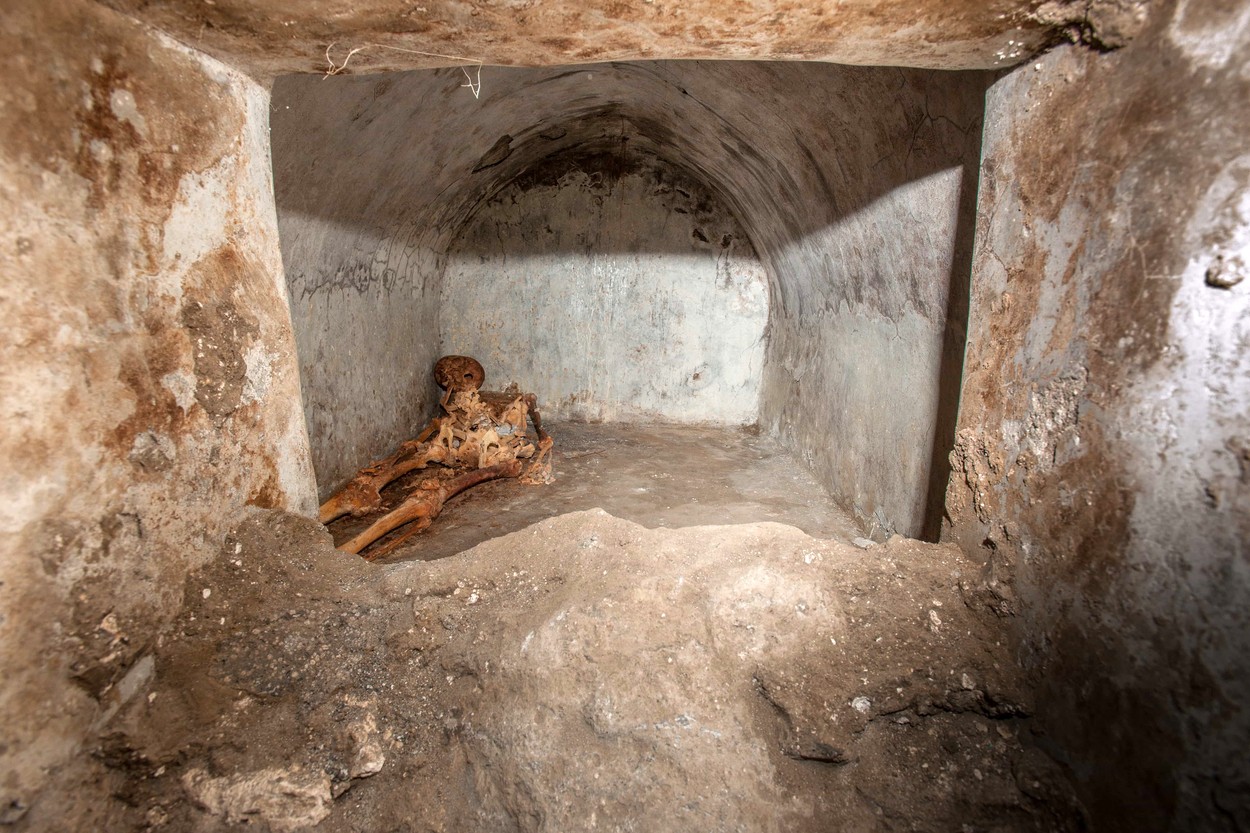 Mummified remains, along with the hair and bones of an individual buried in an ancient tomb have been found at the necropolis of Porta Sarno, to the east of the ancient urban centre of Pompeii, Italy on August, 2021. It is one of the best preserved skeletons ever found in the ancient city. The deceased, Marcus Venerius Secundio a public slave and custodian of the Temple of Venus, was buried in a small cell of 1.6 x 2.4 metres, located behind the main façade, while in the remaining part of the enclosure evidence of cremation has been found, in the form of two cinerary urns, one of which is a beautiful glass container belonging to a woman by the name of Novia Amabilis. During the Roman period at Pompeii, funeral rites usually involved cremation, while only small children were buried.
The burial of Marcus Venerius is thus highly unusual also for the funeral rite that was adopted, considering that he was an adult man over 60 years of age, as evidence emerging from the initial analysis of bones found in the burial chamber indicates. The characteristics of the funerary chamber, which consisted of a hermetically sealed room, created conditions that allowed for the exceptional state of preservation in which the skeleton was found, with hair and an ear still visible. Furthermore, grave goods have been recovered, including two glass unguentaria and numerous fragments of what appears to be fabric. On a marble slab located on the pediment of the tomb, a commemorative inscription to the owner Marcus Venerius Secundio makes reference, extraordinarily, to performances at Pompeii that were conducted in Greek. Experts said it was the first confirmation that Greek was used alongside Latin. The tomb structure, which dates to the final decades in the life of the city, consists of a masonry enclosure, with traces of paint preserved on the façade: it is possible to distinguish green plants on a blue background. The city of Pompeii was destroyed by a volcanic eruption in AD 79. PHOTO: ABACAPRESS.COM,Image: 627471119, License: Rights-managed, Restrictions: , Model Release: no, Credit line: Profimedia
Mummified remains, along with the hair and bones of an individual buried in an ancient tomb have been found at the necropolis of Porta Sarno, to the east of the ancient urban centre of Pompeii, Italy on August, 2021. It is one of the best preserved skeletons ever found in the ancient city. The deceased, Marcus Venerius Secundio a public slave and custodian of the Temple of Venus, was buried in a small cell of 1.6 x 2.4 metres, located behind the main façade, while in the remaining part of the enclosure evidence of cremation has been found, in the form of two cinerary urns, one of which is a beautiful glass container belonging to a woman by the name of Novia Amabilis. During the Roman period at Pompeii, funeral rites usually involved cremation, while only small children were buried.
The burial of Marcus Venerius is thus highly unusual also for the funeral rite that was adopted, considering that he was an adult man over 60 years of age, as evidence emerging from the initial analysis of bones found in the burial chamber indicates. The characteristics of the funerary chamber, which consisted of a hermetically sealed room, created conditions that allowed for the exceptional state of preservation in which the skeleton was found, with hair and an ear still visible. Furthermore, grave goods have been recovered, including two glass unguentaria and numerous fragments of what appears to be fabric. On a marble slab located on the pediment of the tomb, a commemorative inscription to the owner Marcus Venerius Secundio makes reference, extraordinarily, to performances at Pompeii that were conducted in Greek. Experts said it was the first confirmation that Greek was used alongside Latin. The tomb structure, which dates to the final decades in the life of the city, consists of a masonry enclosure, with traces of paint preserved on the façade: it is possible to distinguish green plants on a blue background. The city of Pompeii was destroyed by a volcanic eruption in AD 79. PHOTO: ABACAPRESS.COM,Image: 627471119, License: Rights-managed, Restrictions: , Model Release: no, Credit line: Profimedia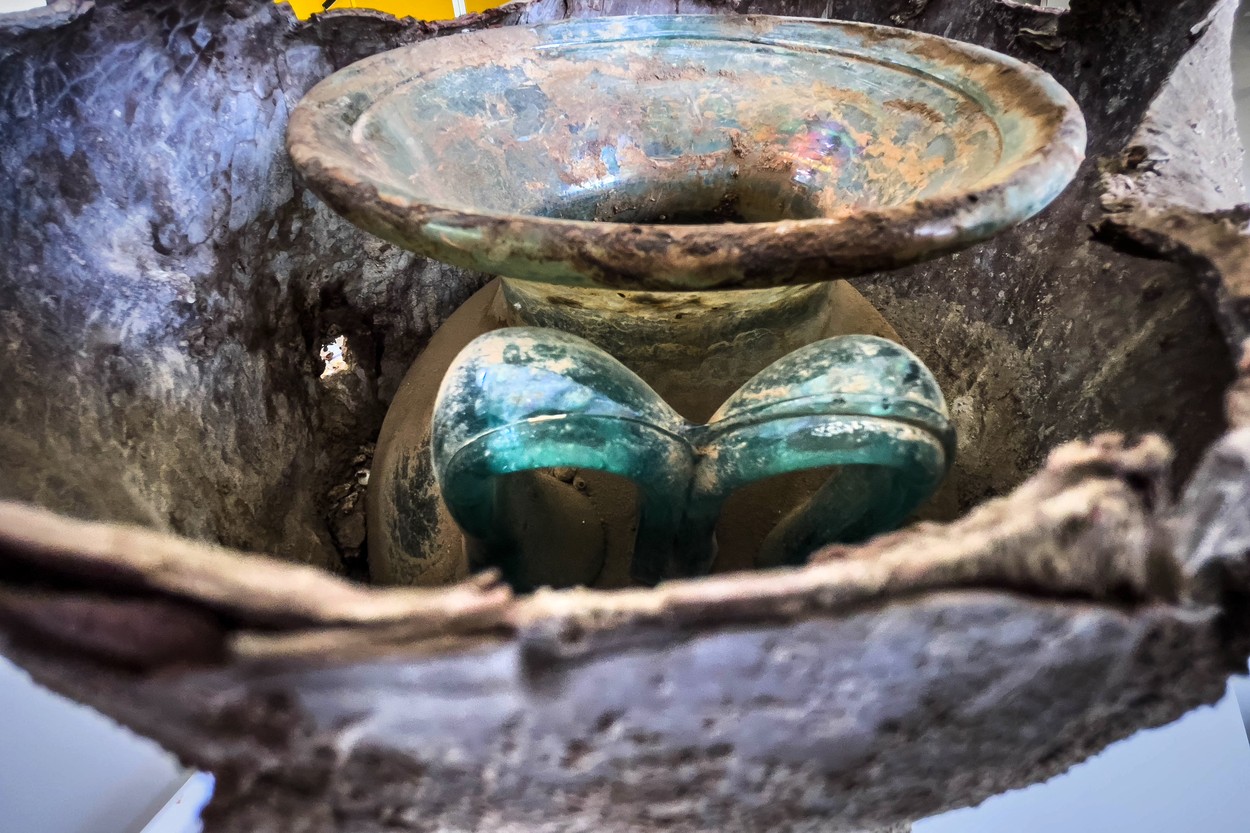 Mummified remains, along with the hair and bones of an individual buried in an ancient tomb have been found at the necropolis of Porta Sarno, to the east of the ancient urban centre of Pompeii, Italy on August, 2021. It is one of the best preserved skeletons ever found in the ancient city. The deceased, Marcus Venerius Secundio a public slave and custodian of the Temple of Venus, was buried in a small cell of 1.6 x 2.4 metres, located behind the main façade, while in the remaining part of the enclosure evidence of cremation has been found, in the form of two cinerary urns, one of which is a beautiful glass container belonging to a woman by the name of Novia Amabilis. During the Roman period at Pompeii, funeral rites usually involved cremation, while only small children were buried.
The burial of Marcus Venerius is thus highly unusual also for the funeral rite that was adopted, considering that he was an adult man over 60 years of age, as evidence emerging from the initial analysis of bones found in the burial chamber indicates. The characteristics of the funerary chamber, which consisted of a hermetically sealed room, created conditions that allowed for the exceptional state of preservation in which the skeleton was found, with hair and an ear still visible. Furthermore, grave goods have been recovered, including two glass unguentaria and numerous fragments of what appears to be fabric. On a marble slab located on the pediment of the tomb, a commemorative inscription to the owner Marcus Venerius Secundio makes reference, extraordinarily, to performances at Pompeii that were conducted in Greek. Experts said it was the first confirmation that Greek was used alongside Latin. The tomb structure, which dates to the final decades in the life of the city, consists of a masonry enclosure, with traces of paint preserved on the façade: it is possible to distinguish green plants on a blue background. The city of Pompeii was destroyed by a volcanic eruption in AD 79. PHOTO: ABACAPRESS.COM,Image: 627471184, License: Rights-managed, Restrictions: , Model Release: no, Credit line: Profimedia
Mummified remains, along with the hair and bones of an individual buried in an ancient tomb have been found at the necropolis of Porta Sarno, to the east of the ancient urban centre of Pompeii, Italy on August, 2021. It is one of the best preserved skeletons ever found in the ancient city. The deceased, Marcus Venerius Secundio a public slave and custodian of the Temple of Venus, was buried in a small cell of 1.6 x 2.4 metres, located behind the main façade, while in the remaining part of the enclosure evidence of cremation has been found, in the form of two cinerary urns, one of which is a beautiful glass container belonging to a woman by the name of Novia Amabilis. During the Roman period at Pompeii, funeral rites usually involved cremation, while only small children were buried.
The burial of Marcus Venerius is thus highly unusual also for the funeral rite that was adopted, considering that he was an adult man over 60 years of age, as evidence emerging from the initial analysis of bones found in the burial chamber indicates. The characteristics of the funerary chamber, which consisted of a hermetically sealed room, created conditions that allowed for the exceptional state of preservation in which the skeleton was found, with hair and an ear still visible. Furthermore, grave goods have been recovered, including two glass unguentaria and numerous fragments of what appears to be fabric. On a marble slab located on the pediment of the tomb, a commemorative inscription to the owner Marcus Venerius Secundio makes reference, extraordinarily, to performances at Pompeii that were conducted in Greek. Experts said it was the first confirmation that Greek was used alongside Latin. The tomb structure, which dates to the final decades in the life of the city, consists of a masonry enclosure, with traces of paint preserved on the façade: it is possible to distinguish green plants on a blue background. The city of Pompeii was destroyed by a volcanic eruption in AD 79. PHOTO: ABACAPRESS.COM,Image: 627471184, License: Rights-managed, Restrictions: , Model Release: no, Credit line: Profimedia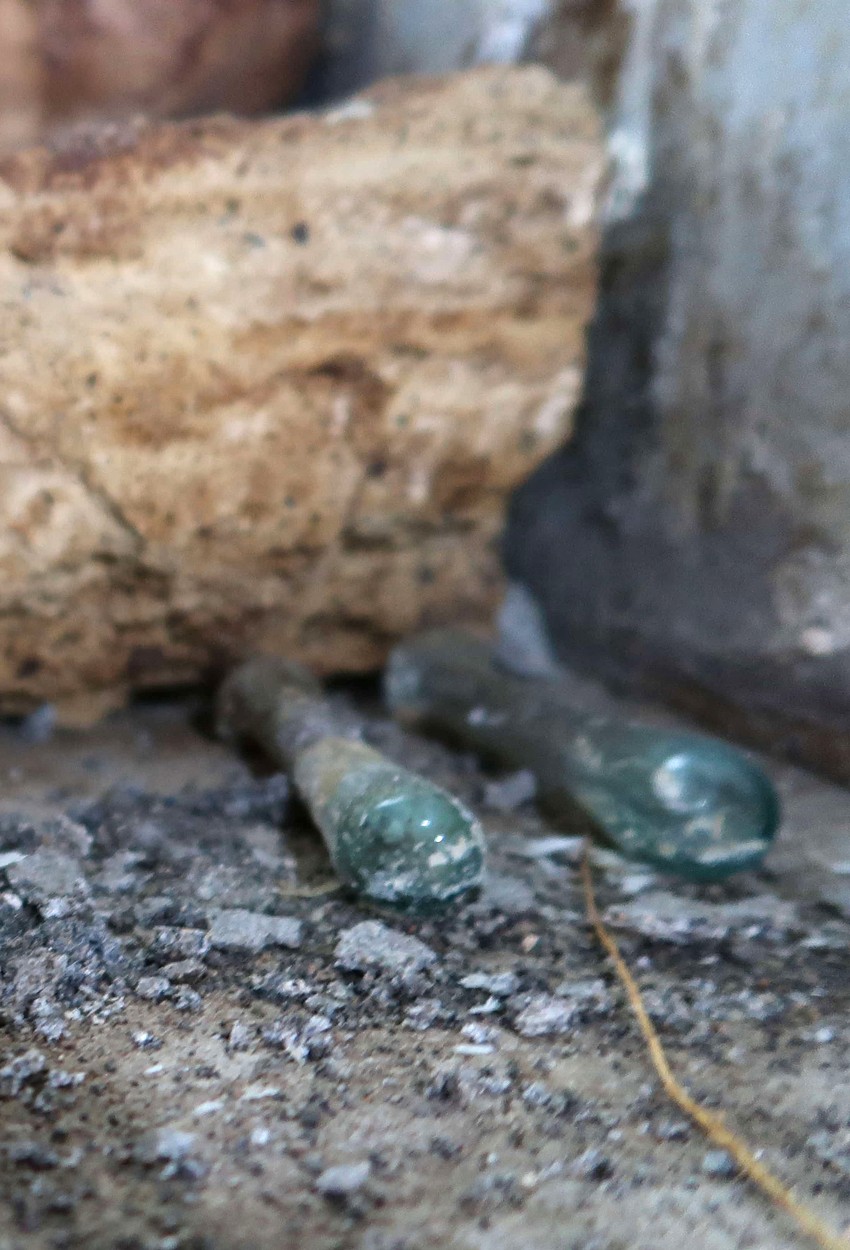 Mummified remains, along with the hair and bones of an individual buried in an ancient tomb have been found at the necropolis of Porta Sarno, to the east of the ancient urban centre of Pompeii, Italy on August, 2021. It is one of the best preserved skeletons ever found in the ancient city. The deceased, Marcus Venerius Secundio a public slave and custodian of the Temple of Venus, was buried in a small cell of 1.6 x 2.4 metres, located behind the main façade, while in the remaining part of the enclosure evidence of cremation has been found, in the form of two cinerary urns, one of which is a beautiful glass container belonging to a woman by the name of Novia Amabilis. During the Roman period at Pompeii, funeral rites usually involved cremation, while only small children were buried.
The burial of Marcus Venerius is thus highly unusual also for the funeral rite that was adopted, considering that he was an adult man over 60 years of age, as evidence emerging from the initial analysis of bones found in the burial chamber indicates. The characteristics of the funerary chamber, which consisted of a hermetically sealed room, created conditions that allowed for the exceptional state of preservation in which the skeleton was found, with hair and an ear still visible. Furthermore, grave goods have been recovered, including two glass unguentaria and numerous fragments of what appears to be fabric. On a marble slab located on the pediment of the tomb, a commemorative inscription to the owner Marcus Venerius Secundio makes reference, extraordinarily, to performances at Pompeii that were conducted in Greek. Experts said it was the first confirmation that Greek was used alongside Latin. The tomb structure, which dates to the final decades in the life of the city, consists of a masonry enclosure, with traces of paint preserved on the façade: it is possible to distinguish green plants on a blue background. The city of Pompeii was destroyed by a volcanic eruption in AD 79. PHOTO: ABACAPRESS.COM,Image: 627471188, License: Rights-managed, Restrictions: , Model Release: no, Credit line: Profimedia
Mummified remains, along with the hair and bones of an individual buried in an ancient tomb have been found at the necropolis of Porta Sarno, to the east of the ancient urban centre of Pompeii, Italy on August, 2021. It is one of the best preserved skeletons ever found in the ancient city. The deceased, Marcus Venerius Secundio a public slave and custodian of the Temple of Venus, was buried in a small cell of 1.6 x 2.4 metres, located behind the main façade, while in the remaining part of the enclosure evidence of cremation has been found, in the form of two cinerary urns, one of which is a beautiful glass container belonging to a woman by the name of Novia Amabilis. During the Roman period at Pompeii, funeral rites usually involved cremation, while only small children were buried.
The burial of Marcus Venerius is thus highly unusual also for the funeral rite that was adopted, considering that he was an adult man over 60 years of age, as evidence emerging from the initial analysis of bones found in the burial chamber indicates. The characteristics of the funerary chamber, which consisted of a hermetically sealed room, created conditions that allowed for the exceptional state of preservation in which the skeleton was found, with hair and an ear still visible. Furthermore, grave goods have been recovered, including two glass unguentaria and numerous fragments of what appears to be fabric. On a marble slab located on the pediment of the tomb, a commemorative inscription to the owner Marcus Venerius Secundio makes reference, extraordinarily, to performances at Pompeii that were conducted in Greek. Experts said it was the first confirmation that Greek was used alongside Latin. The tomb structure, which dates to the final decades in the life of the city, consists of a masonry enclosure, with traces of paint preserved on the façade: it is possible to distinguish green plants on a blue background. The city of Pompeii was destroyed by a volcanic eruption in AD 79. PHOTO: ABACAPRESS.COM,Image: 627471188, License: Rights-managed, Restrictions: , Model Release: no, Credit line: Profimedia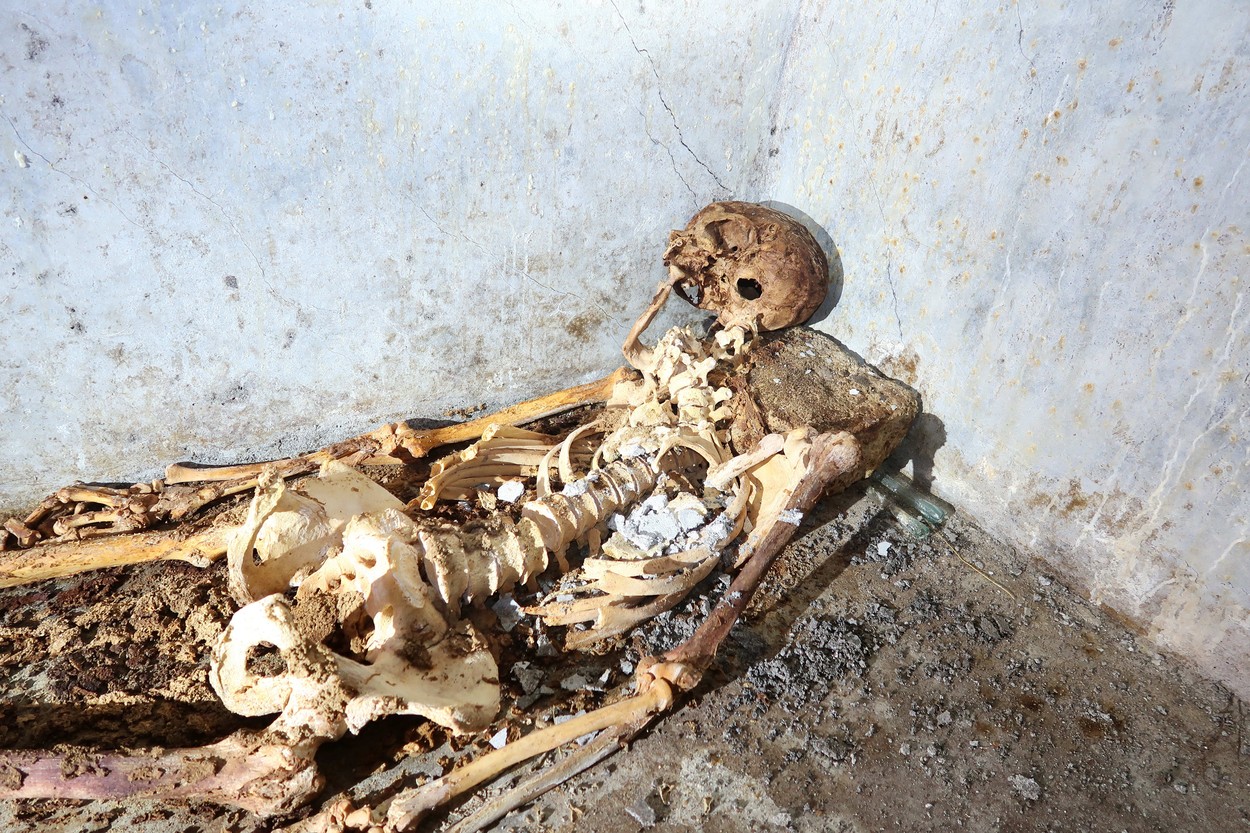 Mummified remains, along with the hair and bones of an individual buried in an ancient tomb have been found at the necropolis of Porta Sarno, to the east of the ancient urban centre of Pompeii, Italy on August, 2021. It is one of the best preserved skeletons ever found in the ancient city. The deceased, Marcus Venerius Secundio a public slave and custodian of the Temple of Venus, was buried in a small cell of 1.6 x 2.4 metres, located behind the main façade, while in the remaining part of the enclosure evidence of cremation has been found, in the form of two cinerary urns, one of which is a beautiful glass container belonging to a woman by the name of Novia Amabilis. During the Roman period at Pompeii, funeral rites usually involved cremation, while only small children were buried.
The burial of Marcus Venerius is thus highly unusual also for the funeral rite that was adopted, considering that he was an adult man over 60 years of age, as evidence emerging from the initial analysis of bones found in the burial chamber indicates. The characteristics of the funerary chamber, which consisted of a hermetically sealed room, created conditions that allowed for the exceptional state of preservation in which the skeleton was found, with hair and an ear still visible. Furthermore, grave goods have been recovered, including two glass unguentaria and numerous fragments of what appears to be fabric. On a marble slab located on the pediment of the tomb, a commemorative inscription to the owner Marcus Venerius Secundio makes reference, extraordinarily, to performances at Pompeii that were conducted in Greek. Experts said it was the first confirmation that Greek was used alongside Latin. The tomb structure, which dates to the final decades in the life of the city, consists of a masonry enclosure, with traces of paint preserved on the façade: it is possible to distinguish green plants on a blue background. The city of Pompeii was destroyed by a volcanic eruption in AD 79. PHOTO: ABACAPRESS.COM,Image: 627471124, License: Rights-managed, Restrictions: , Model Release: no, Credit line: Profimedia
Mummified remains, along with the hair and bones of an individual buried in an ancient tomb have been found at the necropolis of Porta Sarno, to the east of the ancient urban centre of Pompeii, Italy on August, 2021. It is one of the best preserved skeletons ever found in the ancient city. The deceased, Marcus Venerius Secundio a public slave and custodian of the Temple of Venus, was buried in a small cell of 1.6 x 2.4 metres, located behind the main façade, while in the remaining part of the enclosure evidence of cremation has been found, in the form of two cinerary urns, one of which is a beautiful glass container belonging to a woman by the name of Novia Amabilis. During the Roman period at Pompeii, funeral rites usually involved cremation, while only small children were buried.
The burial of Marcus Venerius is thus highly unusual also for the funeral rite that was adopted, considering that he was an adult man over 60 years of age, as evidence emerging from the initial analysis of bones found in the burial chamber indicates. The characteristics of the funerary chamber, which consisted of a hermetically sealed room, created conditions that allowed for the exceptional state of preservation in which the skeleton was found, with hair and an ear still visible. Furthermore, grave goods have been recovered, including two glass unguentaria and numerous fragments of what appears to be fabric. On a marble slab located on the pediment of the tomb, a commemorative inscription to the owner Marcus Venerius Secundio makes reference, extraordinarily, to performances at Pompeii that were conducted in Greek. Experts said it was the first confirmation that Greek was used alongside Latin. The tomb structure, which dates to the final decades in the life of the city, consists of a masonry enclosure, with traces of paint preserved on the façade: it is possible to distinguish green plants on a blue background. The city of Pompeii was destroyed by a volcanic eruption in AD 79. PHOTO: ABACAPRESS.COM,Image: 627471124, License: Rights-managed, Restrictions: , Model Release: no, Credit line: Profimedia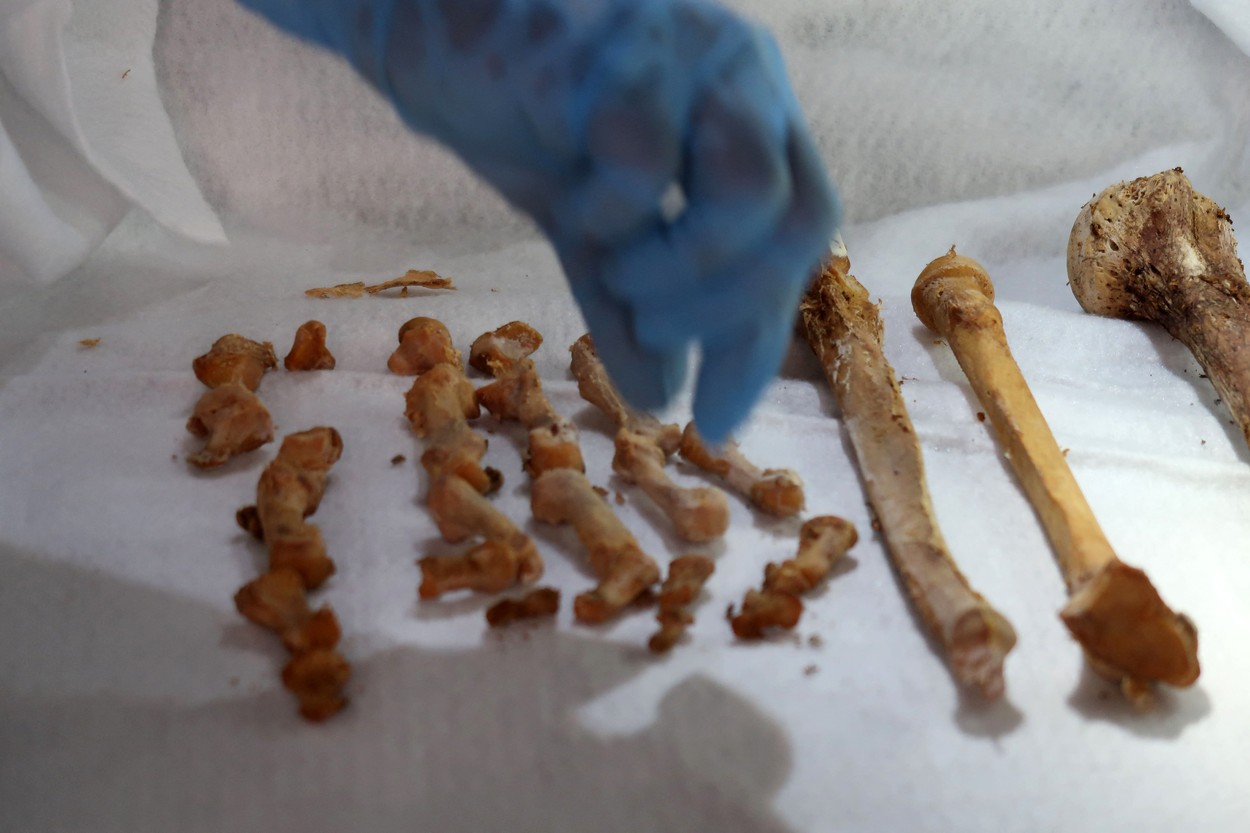 Mummified remains, along with the hair and bones of an individual buried in an ancient tomb have been found at the necropolis of Porta Sarno, to the east of the ancient urban centre of Pompeii, Italy on August, 2021. It is one of the best preserved skeletons ever found in the ancient city. The deceased, Marcus Venerius Secundio a public slave and custodian of the Temple of Venus, was buried in a small cell of 1.6 x 2.4 metres, located behind the main façade, while in the remaining part of the enclosure evidence of cremation has been found, in the form of two cinerary urns, one of which is a beautiful glass container belonging to a woman by the name of Novia Amabilis. During the Roman period at Pompeii, funeral rites usually involved cremation, while only small children were buried.
The burial of Marcus Venerius is thus highly unusual also for the funeral rite that was adopted, considering that he was an adult man over 60 years of age, as evidence emerging from the initial analysis of bones found in the burial chamber indicates. The characteristics of the funerary chamber, which consisted of a hermetically sealed room, created conditions that allowed for the exceptional state of preservation in which the skeleton was found, with hair and an ear still visible. Furthermore, grave goods have been recovered, including two glass unguentaria and numerous fragments of what appears to be fabric. On a marble slab located on the pediment of the tomb, a commemorative inscription to the owner Marcus Venerius Secundio makes reference, extraordinarily, to performances at Pompeii that were conducted in Greek. Experts said it was the first confirmation that Greek was used alongside Latin. The tomb structure, which dates to the final decades in the life of the city, consists of a masonry enclosure, with traces of paint preserved on the façade: it is possible to distinguish green plants on a blue background. The city of Pompeii was destroyed by a volcanic eruption in AD 79. PHOTO: ABACAPRESS.COM,Image: 627471197, License: Rights-managed, Restrictions: , Model Release: no, Credit line: Profimedia
Mummified remains, along with the hair and bones of an individual buried in an ancient tomb have been found at the necropolis of Porta Sarno, to the east of the ancient urban centre of Pompeii, Italy on August, 2021. It is one of the best preserved skeletons ever found in the ancient city. The deceased, Marcus Venerius Secundio a public slave and custodian of the Temple of Venus, was buried in a small cell of 1.6 x 2.4 metres, located behind the main façade, while in the remaining part of the enclosure evidence of cremation has been found, in the form of two cinerary urns, one of which is a beautiful glass container belonging to a woman by the name of Novia Amabilis. During the Roman period at Pompeii, funeral rites usually involved cremation, while only small children were buried.
The burial of Marcus Venerius is thus highly unusual also for the funeral rite that was adopted, considering that he was an adult man over 60 years of age, as evidence emerging from the initial analysis of bones found in the burial chamber indicates. The characteristics of the funerary chamber, which consisted of a hermetically sealed room, created conditions that allowed for the exceptional state of preservation in which the skeleton was found, with hair and an ear still visible. Furthermore, grave goods have been recovered, including two glass unguentaria and numerous fragments of what appears to be fabric. On a marble slab located on the pediment of the tomb, a commemorative inscription to the owner Marcus Venerius Secundio makes reference, extraordinarily, to performances at Pompeii that were conducted in Greek. Experts said it was the first confirmation that Greek was used alongside Latin. The tomb structure, which dates to the final decades in the life of the city, consists of a masonry enclosure, with traces of paint preserved on the façade: it is possible to distinguish green plants on a blue background. The city of Pompeii was destroyed by a volcanic eruption in AD 79. PHOTO: ABACAPRESS.COM,Image: 627471197, License: Rights-managed, Restrictions: , Model Release: no, Credit line: Profimedia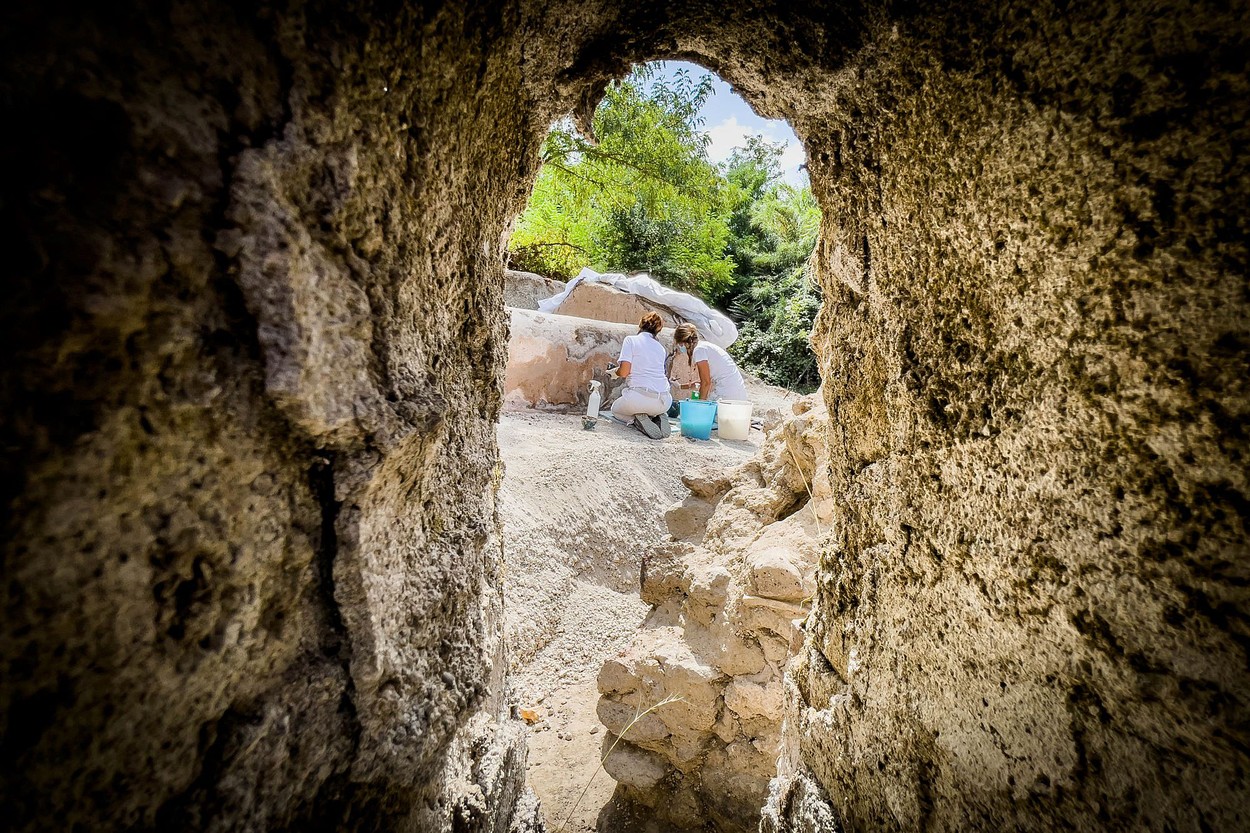 Mummified remains, along with the hair and bones of an individual buried in an ancient tomb have been found at the necropolis of Porta Sarno, to the east of the ancient urban centre of Pompeii, Italy on August, 2021. It is one of the best preserved skeletons ever found in the ancient city. The deceased, Marcus Venerius Secundio a public slave and custodian of the Temple of Venus, was buried in a small cell of 1.6 x 2.4 metres, located behind the main façade, while in the remaining part of the enclosure evidence of cremation has been found, in the form of two cinerary urns, one of which is a beautiful glass container belonging to a woman by the name of Novia Amabilis. During the Roman period at Pompeii, funeral rites usually involved cremation, while only small children were buried.
The burial of Marcus Venerius is thus highly unusual also for the funeral rite that was adopted, considering that he was an adult man over 60 years of age, as evidence emerging from the initial analysis of bones found in the burial chamber indicates. The characteristics of the funerary chamber, which consisted of a hermetically sealed room, created conditions that allowed for the exceptional state of preservation in which the skeleton was found, with hair and an ear still visible. Furthermore, grave goods have been recovered, including two glass unguentaria and numerous fragments of what appears to be fabric. On a marble slab located on the pediment of the tomb, a commemorative inscription to the owner Marcus Venerius Secundio makes reference, extraordinarily, to performances at Pompeii that were conducted in Greek. Experts said it was the first confirmation that Greek was used alongside Latin. The tomb structure, which dates to the final decades in the life of the city, consists of a masonry enclosure, with traces of paint preserved on the façade: it is possible to distinguish green plants on a blue background. The city of Pompeii was destroyed by a volcanic eruption in AD 79. PHOTO: ABACAPRESS.COM,Image: 627471166, License: Rights-managed, Restrictions: , Model Release: no, Credit line: Profimedia
Mummified remains, along with the hair and bones of an individual buried in an ancient tomb have been found at the necropolis of Porta Sarno, to the east of the ancient urban centre of Pompeii, Italy on August, 2021. It is one of the best preserved skeletons ever found in the ancient city. The deceased, Marcus Venerius Secundio a public slave and custodian of the Temple of Venus, was buried in a small cell of 1.6 x 2.4 metres, located behind the main façade, while in the remaining part of the enclosure evidence of cremation has been found, in the form of two cinerary urns, one of which is a beautiful glass container belonging to a woman by the name of Novia Amabilis. During the Roman period at Pompeii, funeral rites usually involved cremation, while only small children were buried.
The burial of Marcus Venerius is thus highly unusual also for the funeral rite that was adopted, considering that he was an adult man over 60 years of age, as evidence emerging from the initial analysis of bones found in the burial chamber indicates. The characteristics of the funerary chamber, which consisted of a hermetically sealed room, created conditions that allowed for the exceptional state of preservation in which the skeleton was found, with hair and an ear still visible. Furthermore, grave goods have been recovered, including two glass unguentaria and numerous fragments of what appears to be fabric. On a marble slab located on the pediment of the tomb, a commemorative inscription to the owner Marcus Venerius Secundio makes reference, extraordinarily, to performances at Pompeii that were conducted in Greek. Experts said it was the first confirmation that Greek was used alongside Latin. The tomb structure, which dates to the final decades in the life of the city, consists of a masonry enclosure, with traces of paint preserved on the façade: it is possible to distinguish green plants on a blue background. The city of Pompeii was destroyed by a volcanic eruption in AD 79. PHOTO: ABACAPRESS.COM,Image: 627471166, License: Rights-managed, Restrictions: , Model Release: no, Credit line: Profimedia





comentarii: